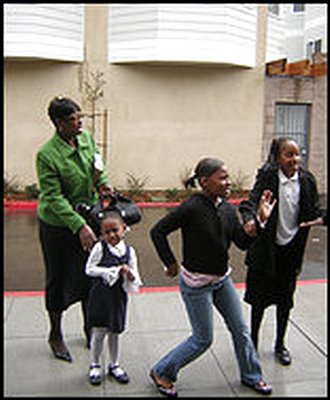Where Did All the Children Go?

In San Francisco and Other Big Cities, Costs Drive Out Middle-Class Families
By John PomfretWashington Post Staff WriterSunday, March 19, 2006; Page A03
SAN FRANCISCO -- Monica Burton did not want to leave San Francisco. Born and raised in the city and a train driver for the Muni transit system for the past 16 years, she loves her home town, volunteers in its women's jail and prays weekly at her church in the Hunter's Point section along the San Francisco Bay.
But as the main breadwinner for her family, which includes a 22-year-old daughter and two granddaughters, she faced some hard choices. Stay in San Francisco and abandon the dream of owning her own home because of skyrocketing housing prices, or leave. In 2004, Burton left with her grandchildren, buying a three-bedroom house in what she calls a "Leave It to Beaver" neighborhood in Sacramento, a 158-mile round-trip commute from her job in the city of her birth.
People like Burton have been leaving U.S. cities because of high-priced housing for some time. But according to researchers and urban leaders, the trend has accelerated in recent years and is threatening to reshape many of the nation's major cities. Between 2000 and 2004, all eight metropolitan regions from Seattle to San Diego lost middle-class families.
On the East Coast, a similar trend is underway, with middle-class families fleeing the New York region and Boston for the South. The District has been in the buffer zone, losing middle-class families with children to the Sun Belt but gaining some from the Northeast, said William Frey, a demographer at the Brookings Institution.
"There's a middle-class flight on both sides of the country," said Frey, who has analyzed county-level census data on both coasts. He has found that real estate costs more than schools are driving the migration.
The trend has city officials worried about what the loss of these middle-class families will do to the vitality of their communities, and they are trying to find ways to stem the flow.
The departure of families is being felt especially hard in San Francisco, which is losing children at a rate that outpaces the rest of the region. Researchers, including Frey, say the skyrocketing cost of housing, more than the fact that the city is a center of gay life, is the crucial factor. San Francisco risks turning into Venice, Italy -- a beautiful tourist town with few long-term residents and no families, said Gabriel Metcalf, executive director of the San Francisco Planning and Urban Research Association, which has advocated changes in zoning and the construction of not just more subsidized housing but also more market-rate housing.
A recent survey by the Public Research Institute at San Francisco State University found that respondents with family incomes higher than $50,000 were almost twice as likely to say they planned on leaving San Francisco as people from lower income brackets.
Commuting From Montana
More than half of San Francisco's firefighters, police officers, emergency medical workers, nurses and teachers live outside the city, city figures show. Firefighters, who work 24-hour shifts, commute to San Francisco from as far away as Montana. With median house prices in San Francisco hitting $780,000 and a similar profile in cities up and down the West Coast, the California Dream is no longer possible for most Americans, the report said.
"My two neighbors with kids are leaving, one to Portland and the other to Virginia," said Holly Shafer, one of the researchers on the project. "They just want to be able to buy a place." Shafer predicts that San Francisco, like other West Coast cities, will soon become home to only the very rich and the poor.
Blacks Lead Exodus
In San Francisco as on other parts of the West Coast, African Americans such as Burton are leading the charge, although white families are not far behind. From 1990 to 2000, San Francisco lost 45 percent of its black children, according to U.S. census data. From 2000 to 2004, an additional 15 percent left the city, bringing the total number of African American children under 10,000 for the first time in decades.
From 2000 to 2004, the number of black children fell in the eight major metropolitan areas from Seattle to San Diego. The number of white children declined in seven. Immigrant families -- from Asia and Latin America and generally in the lower income brackets -- accounted for whatever growth there was in the number of children along the coast, Frey said. >>>cont
Link Here




0 Comments:
Post a Comment
<< Home